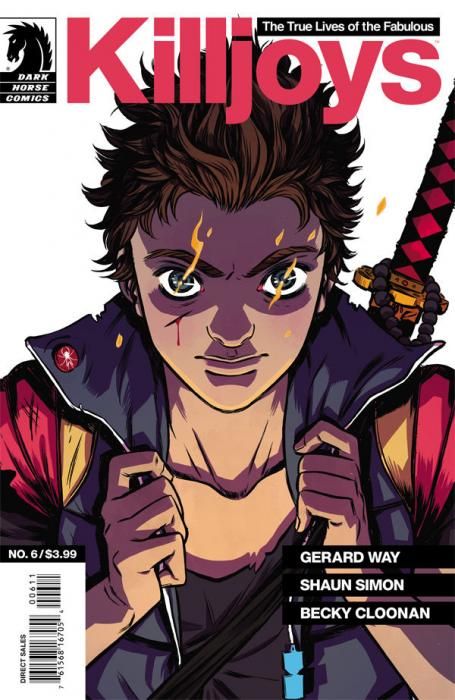The finale of "The True Lives of the Fabulous Killjoys" isn't quite fabulous, but it's definitely fierce. With a lot of plot to tie up in not a great deal of pages, this ferociously paced issue provides more than its fair share of story. Racing to the finish line, True Lives offers a satisfying climax but can't always compensate for the previous lack of build-up.
Now, I would buy at least seven copies of "Becky Cloonan Illustrates the Indistinct White Light You See After Working at a Computer Too Long," so I wasn't exactly shocked that her work on a band of anarchic desert punks and their dystopian megalopolis utterly enthralled me. Her strong graphic style is perfect for a book with this much panache. Plus, she's got a wonderful sense for the weird and funky, and this part future-city, part sci-fi-junkyard universe puts that skill to great use. Dan Jackson's colors are also phenomenal. From the pulsing blue of Blue's hair to the epic green of Battery City's electricity-trapped souls, he paints a mix of gritty and garish that feels like a really awesome band's first paying gig. Together, Cloonan and Jackson offer up pages you can look at again and again.
Way and Simon' script, however, is a mixed bag. They tie their three storylines together compellingly, even though Blue, Korse and the Girl never have an intersecting arc. When writers can't double-dip on storylines, that puts the impetus on them to make the most of each panel -- especially in a final issue -- and Way and Simon produce a neat plot that hits all the important points. It isn't easy to cram that much in, but by keeping the storylines so independent, they've let the reader see much more of the world they've created. In a sci-fi romp like this, the world is half the fun, so it was smart of them to highlight it in all its facets.
Still, they continue to hit everything in broad strokes. There's something's commendable and adolescently charming about the obviousness of the series' themes and the boldness with which it goes for them -- very rock and roll. However, as a result, its revolutionary characters don't feel motivated by specific, social needs; they speak in wide-ranging, not-quite-defined principles. Goals like "free them all" and "individuality" are certainly ideas that the reader can get behind, but it's tough to create a sense of momentum heading toward those goals. It's a real leap to tie the concrete steps that the characters take to the fulfillment of such abstract principles, whereas more grounded goals -- overthrow a dictator, take out B.L.I.'s power source -- would tie more clearly to concrete steps and increase the audience's sense of the characters' agency.
However, perhaps the characters aren't really the point here. B.L.I. was always meant to fall, and the heirs to the original Killjoys were always meant to triumph. As a symbol-heavy, go-all-out series, True Lives of the Fabulous Killjoys is an easy-to-consume, joy-to-read treat.

